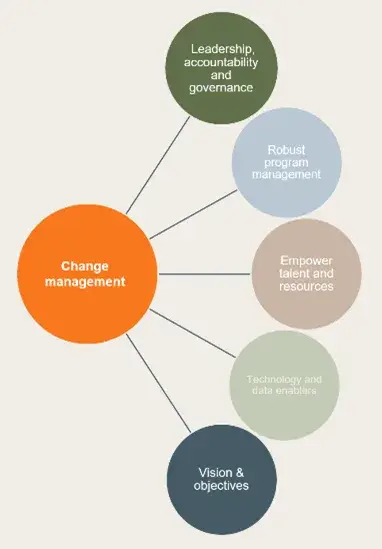While transition planning may be precipitated by climate change, business change is a familiar feature of corporate management. This unlock articulates how a company can use a business change management framework to implement the transformation necessary in a transition to a net zero economy.
This series is comprised of five insight notes focusing on key areas of business focus to “unlock” transition plans and builds on insight and perspectives shared by WBCSD members who joined the Unlocking Transition Planning session held at our Council Meeting in New York in September 2024. Each of the areas is explored in the series of articles available here.
Importance of a business change management framework
Business change is not new. Successful business organizations already need to be capable of adapting to dramatically changing business context. These can be market and sector specific, such as the entrant of new disruptive technologies, competitors or sectoral policies, or market- or economy-wide, like, pivoting to renewable energy (e.g. Ørsted), major regulatory change (e.g. Sarbanes-Oxley Act), geopolitical events (e.g. Brexit, opening of markets of China), digitalization (e.g. automation of production lines, adoption of 5G technology), or new economic policy environments (e.g. European Green Deal).
Most businesses already have access to the core tools to deliver transition plans in the form of business change management frameworks (e.g. McKinsey 7-S Model, ADKAR Model). A business change management framework provides the tools (e.g. strategic planning, business process analysis, change impact and readiness techniques) to guide organizations through the complexities of change and to deliver transition vision and objectives in an integrated manner and as part of a strategic approach to business change. These corporate management tools can be applied to the context of net zero transition as well.
Relevance to transition plans
Many businesses will need to undergo robust change to compete in, and contribute to, a net zero economy. It can demand a comprehensive shift in what businesses do and how they do it that requires significant changes by economic actors across the global economy at an individual and organizational level. This is particularly true for businesses whose sources of revenue or operations heavily rely on GHG-emitting products or production processes. Although the extent of business change and the demands and solutions will vary across industries and sectors, all organizations – and the people within them – will need to evaluate how the net zero transition will alter their business models, strategies and operations and execute some level of transformation.
Companies must keep their business models and market strategies profitable, and future-ready, showing how they’ll evolve products, services, and processes to meet the rising demand for sustainable, net-zero solutions (e.g. renewable energy, shift to electric vehicles, circular economy in retail, green steel). For companies committed to social and environmental sustainability, it also entails articulating business’s performance in terms of personal, societal and economic growth decoupled from greenhouse gas emissions and with climate, nature and societal-positive outcomes. The key requirements for implementing a transition plan should focus on delivering transparent, accountable and credible transition strategies that are integrated into the business processes.
Successful and strategic business transition can be:
- Grounded upon and leverage change management frameworks.
- Delivered through existing transformation or change management disciplines and capabilities.
- Implemented with a strategic focus on integration with wider operational and business processes and priorities.
Once a company has identified its strategic focus and business model priorities, applying transformation management techniques can enable implementation disciplines that will unlock transition plans and deliver transition.
Transition-focused actions for business transformation
Transition-focused action is essential for organizations to adapt and thrive in a world transitioning to sustainability imperatives, climate change, and shifts in economic priorities. To drive business transformation in support of transition requires Boards and senior management to build the organizational foundation for sustainable transformation with regard to the following actions.

- Establish strong leadership, accountability & governance
Leadership and governance are critical to the successful delivery of business change . Boards and Executive Management teams not only need to demonstrate visionary leadership, but they also need to demonstrate a strong understanding of their duties, roles and responsibilities. This requires Board and Executive training and upskilling
Effective governance is essential for ensuring accountability and providing oversight across the organization. A clear governance structure should be established to define roles and responsibilities that oversee key steps to deliver business transformation. This structure ensures that all parts of the organization actively buy-in and understand expected contributions to organizational change.
Considerations to enable transition include:
- Secure Executive and Board engagement through training, building awareness of fiduciary duties, regulatory requirements and the business case for transition.
- Establish a clear governance structure – e.g. a dedicated committee including key executives and cross-functional leaders, responsible for setting transition priorities, monitoring progress and making critical decisions.
- Set clear accountability and ownership linked to transition objectives through accountability frameworks and integrated performance frameworks, designated roles and responsibilities and links to remuneration.
- Apply a robust program management approach
Delivery of business transformation can demand change to business models, operations and strategies. A robust program management approach is a pre-requisite of turning big strategy and ambition into action. Successful business change relies on structured and phased process to planning, resourcing and implementation. Effective program management ensures that the planned initiatives are carried out systematically, addressing practical challenges whilst keeping the organization aligned with its goals. For example, an organization might create detailed roadmaps with milestones, establish project management discipline and oversight, and use agile methods to adapt and respond dynamically to emerging challenges.
Considerations to mobilize and execute transition plans include:
- Establish a Program Management Office leveraging existing change management structures, assign executive ownership, and have them oversee creation of a detailed transition roadmap.
- Utilise business process, strategy and change impact techniques to conduct assessments against regulatory and market standards to identify priority actions and critical gaps in transition programs.
- Appoint a clear Program Lead and assign executive accountability for delivery of the transition roadmap.
- Establish cross-function project teams and resource allocation models to enable coordinated, cross-organizational execution of transition programs.
- Empower talent and resources
Organizations need to foster a culture that supports transformational change and to develop the necessary talent pool, technical skills and business environment to support the new practices to deliver new actions, processes and behaviours across the organization.
Approaches such as integrated performance management frameworks can build good practices to incorporate relevant climate transition and sustainability strategy factors into the organization’s talent development strategy, resource allocation, and human capital management processes – e.g. clearly defining an organizational purpose, developing a robust strategy and implementing effective corporate governance practices that can underpin the organizational change.
Example actions include:
- Undertaking skills assessment and development review to identify the skills and competencies needed for transition and assess gaps in the current workforce.
- Developing and implementing training programs to upskill employees on transition strategy, responsibilities, operational changes, new technologies and sustainability-related needs.
- Enhancing resource management by connecting individual objectives and goals to reflect transition planning targets and objectives.
- Encouraging employee-led initiatives and fostering grassroots support for transition objectives.
- Exploring options to implement an integrated performance management approach to connecting individual and team performance with corporate performance, strategy, and purpose.
- Identify Information Technology & data enablers
Data systems and digital solutions are fundamental components of today’s business and operating models and leveraging data technology and innovation are essential to achieving business transformation.
Building and applying a clear information technology strategy is central to effective implementation of business change and has become crucial for transition. In the first instance, organizations need to have a strong understanding of how existing technology and data management capabilities will be applied and integrated to deliver transition-relevant information and capabilities. An assessment of existing technology capabilities and gaps – e.g. to collate and assess business performance or emissions across value chains – is a fundamental first step.
A further important step is to identify the technology developments and innovations upon which effective transition and operational performance are critically dependent. By understanding how and where existing technology can be leveraged and where investment in new technologies or innovation is necessary, organizations can develop technology-enabled transition strategies that deliver business change with limited business disruption.
Practical considerations include:
- Assessing the existing technology suite and developing a clear data strategy to address gaps and needs related to transition objectives.
- Assess and invest in new data, systems and technologies to support new processes, operating models, products and services.
- Assessing the types and quality of data required for both transition disclosure and implementation purposes to ensure that the data used is as accurate and relevant as possible.
- Developing a data improvement action plan, which should be a core component of any initial transition plan, to continuously enhance the quality and robustness of required data over time.
- Starting to build a data and technology infrastructure and management system as soon as possible.
- Create a clear vision and defined strategic objectives
A clearly defined vision and objectives are necessary for business change. This process requires identifying and setting business priorities that clearly articulate the discrete changes that will drive change and integrate into the organization’s strategy.
Considerations to enable transition include:
- Clearly articulate the vision and objectives will help the company adapt to, and contribute to, a net-zero economy and, where relevant, other environmental, social, and governance issues.
- Clarifying the organization’s transition priorities and explain how these integrate into near-term and long-term business strategies.
- Driving Board and Executive buy-in through building a transition business case that focuses on value rather than regulatory compliance and aspiration.
- Establishing a clear communications strategy – internally and externally – to share the vision and strategic importance for transition as a business imperative.
- Fostering a culture that prioritizes transition action through recognition, reward and incentivization linked to transition priorities and goals.
- Engaging with investors, lenders, or other relevant stakeholders to clarify expectations and regarding strategic priorities, information and data needed to make informed capital/ finance allocation decisions supportive of transition.
Key takeaways
Transition planning starts when a transition plan is embedded into the overall business strategy, operational plans and targets where relevant. In some instances, this can’t be done without deep organizational changes. Internal functions will need to collaborate, supported by clear communication, targets, and investments, and crucially, be held accountable and committed. Strategic planning is essential for ensuring alignment, guiding management, and achieving effective implementation. A robust transition plan provides the North Star, or blueprint, to kick off this process and to enable transition goals and priorities to be aligned with core business strategy. An effective change management function provides an operational foundation for implementation.
- Utilize your business change management framework to deliver transition plans.
- Focus beyond regulatory and compliance. Transition is not about reporting and disclosure. It involves an evolution of business strategies, goals and operating models.
- A pre-requisite for strategic, cross-organizational transition is to establish clear vision, leadership and governance.
- Robust program management is essential.
- Be clear on how and where you need to train, upskill and build your talent pool.
- Have an information technology and data strategy with clear views on where existing technology can be leveraged and where innovation is required (and on what timeframe).
- Focus on business change management as one of the key thematic unlocks to implement transition plans.
Contact
Corporate Performance & Accountability cp-a@wbcsd.org
Outline

